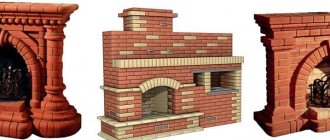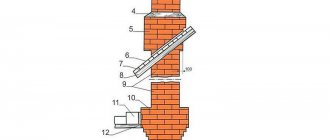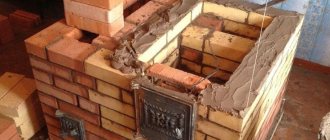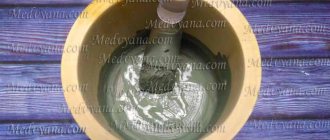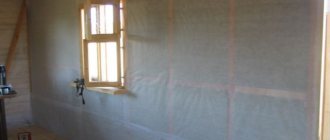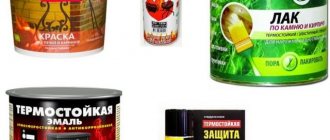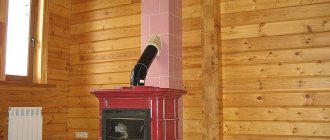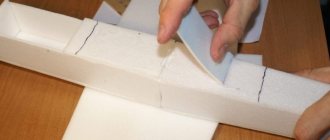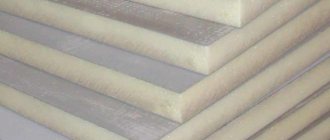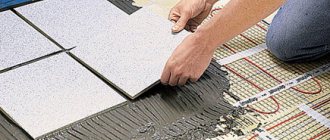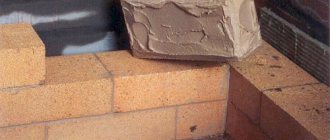An important step in building a stove for a country house or bathhouse is preparing a reliable masonry mortar.
Properly mixed mortar for laying a stove affects the tightness, durability, heat resistance and safety of the finished structure.
A good mixture for laying a stove is resistant to high temperatures, mechanical damage and cracking.
Features of material selection
The process of constructing modern stoves is divided into several stages:
- The first stage is the arrangement of the furnace foundation using a concrete composition;
- The second stage is the laying of a furnace from refractory bricks using a clay-based masonry compound;
- The third stage is lining the furnace with a plaster composition.
The most important is the stage of direct masonry and the preparation of a reliable base, which must have high performance characteristics - heat resistance, adhesion, water resistance, strength and durability.
To equip modern stoves, several types of masonry mortars are used: clay, lime and cement.
Masonry mortars can be simple or complex. Simple ones consist of one type of binder and filler; complex mixtures include two or more binders and several aggregates. Binding components are lime, clay and cement.
To prepare the mortar for masonry, you will need the following tools:
- Mixer;
- Kneading container;
- Sieve;
- Trowel;
- Master OK;
- Plastic spatula;
- Construction thermometer;
- Scales.
How to use ready-made mixtures
Despite the fact that the technology and procedure for using ready-made mixtures for laying stoves from purchased packaging are simplified as much as possible, you should pay attention to the mixing method. To do this, you will definitely have to use a mixer or a kind of attachment on a drill. If you try to mix it manually, you may unwittingly disrupt the technology used to prepare the solution for the fireplace.
In order to reduce the impact force, many people uncontrollably add excessive amounts of water. An error in kneading can be corrected by adding more mixture if there is any left. Evaporation of liquid already leads to disruption of technology.
The mortar for laying the fireplace needs to be prepared in portions. Start with small volumes, since initially it is impossible to determine the speed of masonry. Approximate operating time is about 60 minutes. The frozen solution cannot be re-mixed. The manufacturer indicates only approximate proportions, since a more precise amount of water depends on external conditions.
Using a mixer will simplify the work and allow you to make a uniform mixture
The most practical method is not to add the mixture to water, but to add water to the mixture powder. With this method you can control the consistency of the mixture. The study can be carried out with one movement of the trowel. To check the quality of the composition you have prepared, simply move the top layer horizontally relative to the lower layers.
- If the solution is heterogeneous and forms rips in many places, then this is a clear sign of a lack of moisture. When the groove formed by the trowel immediately floats, you will have to add dry powder.
- If the mark from the trowel remains static for a long time, then the solution for the brick fireplace is optimally prepared.
Good to know: How a fireplace door is made, how to do the work yourself
The main advantage of ready-made mixtures is the ability to retain moisture. In the case of a homemade mortar, the bricks would have to be wetted before laying so that the air would escape from the pores. Uniform drying of the seams ensures the absence of cracks in the masonry. Professional craftsmen can perform brickwork with the smallest possible seam; aesthetically, this result is the highest degree of professionalism.
Brick laying with minimal seam
After completion of the construction of the structure, the fireplace or stove cannot be lit immediately. It will take several days for the solution to dry properly. It is possible that the final hardening of the mixture will occur while the device is running, but before cladding you need to operate the fireplace for a week.
Clay based
One of the cheapest and most accessible types of connecting stove mixtures. Clay mortar for laying stoves is characterized by increased fat content, which determines the degree of plasticity, heat resistance and strength of the finished material.
Natural clay oven mortar can be:
- Fat – characterized by plasticity, strength, but the rapid appearance of cracks after drying;
- Normal - quite plastic and resistant to cracking, gives a small percentage of shrinkage after drying. Able to withstand high temperatures up to 110 degrees;
- Skinny - non-plastic and short-lived, susceptible to rapid delamination and crumbling.
A refractory clay mortar is prepared using three components: clay, sand and water. This composition is resistant to cracking and drying out and ensures reliable installation of a brick stove.
To build a stove, it is recommended to use fatty and normal compositions, which have increased strength, ductility and resistance to delamination.
The quality of the clay determines the amount of sand needed to mix the solution. Clay and purified water with a low content of impurities are used for work. To lay 100 bricks, on average, up to 20 liters of clean water are used.
To prepare the solution, fine-grained quarry or river sand without additional impurities is used. Before use, it must be sifted through a fine-mesh sieve. If it contains gravel impurities, then it is recommended to use a sieve with a mesh size of up to 10 mm. For fine-grained material, a sieve with 2 mm cells is suitable.
Before adding other components, it is recommended to test the clay base for plasticity. How to do such a check? To do this, a small board should be lowered into the resulting mixture for laying the stove and its thickness should be determined. It should be moderately thick and viscous. If there is excess liquid, then it is worth adding a little binder, stirring periodically and testing the mixture for plasticity.
The optimal thickness of the connecting material is 2 mm, which indicates the correct proportions of all components. The finished masonry mass is viscous and not very dense.
The appropriate density of the mortar for masonry depends on the ratio of the main components in it - clay and sand, respectively:
- Fat mass – 1:2;
- Normal weight – 1:1;
- Lean mass – 2:1.
Methods for preparing clay composition
How to prepare high-quality clay-based connecting mass? There are several proven methods.
Method No. 1
The required volume of clay is soaked for 24 hours, water is added to obtain a thick mass. The resulting material is carefully filtered, then sand is added to it and mixed again. It is important to avoid the formation of clay puddles, which can be eliminated with a small portion of the binder component.
Method No. 2
Fireclay sand and clay are combined in a container in equal proportions, purified water is added (1/4 of the volume of clay). All components are thoroughly mixed until a homogeneous mass is obtained.
Method No. 3
The composition is mixed on the basis of loam. This recipe involves preparing 10 different solutions, from which the best one is selected.
For the first: 10 volumes of loam, 1 volume of sand and 1 volume of cement, etc. Descending volume of loam. Ten resulting bases are placed in different containers and left to dry for 5-6 days. At the end of the allotted time, the highest quality composition of the solution with a minimum degree of shrinkage and resistance to cracking is determined.
Method No. 4
Sand and ¼ water are added to the clay. All components are mixed to obtain a thick viscous mass. To increase strength, it is recommended to add rock salt or cement to such a mixture. For a bucket of mixture – up to 250 g of salt and ¾ liter of cement. The salt is first dissolved in water, and the cement is diluted with water to a thick consistency, after which it is added to the finished base.
Classification of mixtures
Purchasing ready-made mixtures for laying fireplaces saves the master from many problems. To get a solution, you just need to add a certain amount of water and thoroughly mix the dry fraction in it. Detailed preparation method and proportions are indicated in the instructions. The mixture contains all the necessary ingredients, precisely calculated in quantity.
Preparing the solution yourself will significantly save your budget, since the total cost of all materials will be lower than the price for the same amount of store-bought product. But when preparing a solution, no one guarantees complete compliance with the proportions. In addition, factory materials contain various additives that can enhance any property of the solution.
For example, to ensure that the finished solution does not contain pores with air, which will cause combustion products to penetrate the walls of the firebox, special binders are added to the masonry mixture. If you prepare the solution yourself, these problems have to be solved in a different, more complex way.
Ready-made composition from a well-known manufacturer
Each manufacturer is ready to present three main types of mixtures for various purposes. Their composition has certain differences, which affects the basic technical properties of the solution.
- Mixtures based on clay and sand are used when laying the firebox and fireplace walls. The prepared solution is suitable for laying linings and has a high degree of fire resistance.
- By adding cement to clay, you can increase its adhesion properties. The use of lime will add strength to the masonry. Clay-lime mortars are used in the construction of the upper rows of the chimney, where the effect of high temperatures is not so pronounced, but aggressive climate influences are added.
- Cement mixtures with the addition of sand have a high strength threshold. This composition is ideal for pouring the foundation, which will bear all the physical load from the structure.
Good to know: How a fireplace with a heat exchanger works, how to use it correctly
Some mixtures used for exterior finishing contain gypsum. But when choosing, everyone must rely on their own strengths in order to assess the efficiency of the work. There are substances with radically opposite properties. The plasticizers they contain do not allow the finished solution to harden quickly and allow the master to adjust the masonry over a certain period of time.
Lime based
For the construction of the foundation and stove chimney, it is recommended to use a composition based on lime and cement.
A special dough made by mixing quicklime and water in a 3:1 ratio. Sifted sand is added to the finished dough through a fine-mesh sieve in a ratio of 3:1 - 3 volumes of sand to 1 volume of dough. The finished mass is diluted with water until a thick mass is obtained.
The mixture for laying a lime-based stove is quite plastic and durable.
The fat content of the lime composition is determined by the amount of sand. For an excessively fatty mixture, 5 volumes of the sand component are required, for a normal mixture - no more than 3 volumes.
Strength and water resistance can be increased by adding cement. To prepare such a composition, it is necessary to use the components in the following proportions (parts):
- Cement – 1;
- Sand – 10;
- Lime dough – 2.
Preparation of the solution has the following sequence of actions: cement and sand components are combined in a separate container. The finished lime-based dough is diluted with purified water until a thick consistency is obtained. Add bulk ingredients to the diluted dough and mix. To increase viscosity, the composition is diluted with water.
